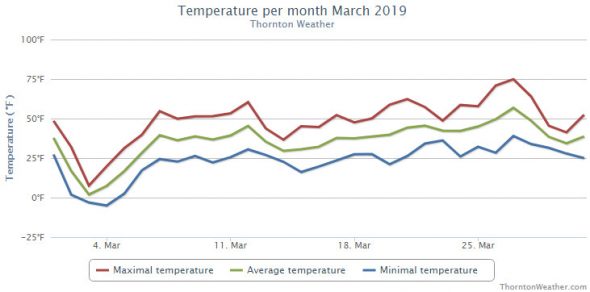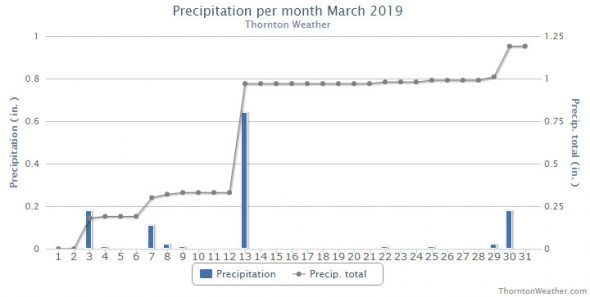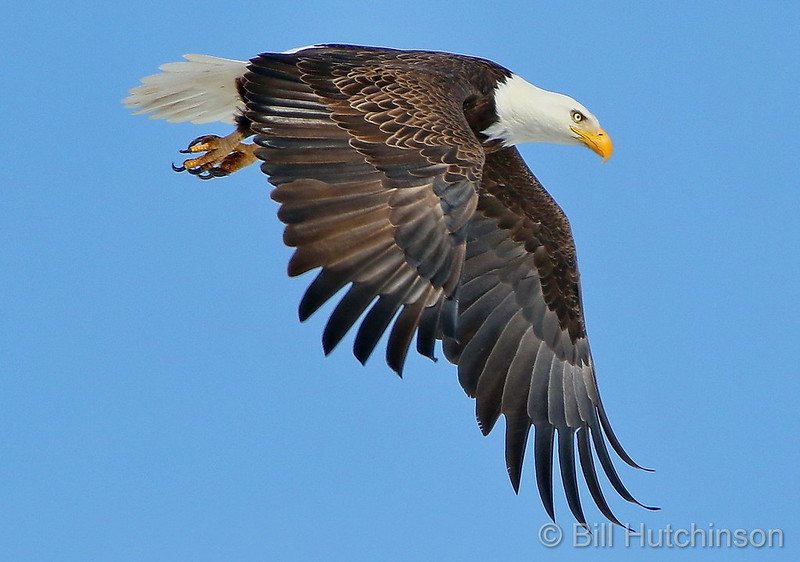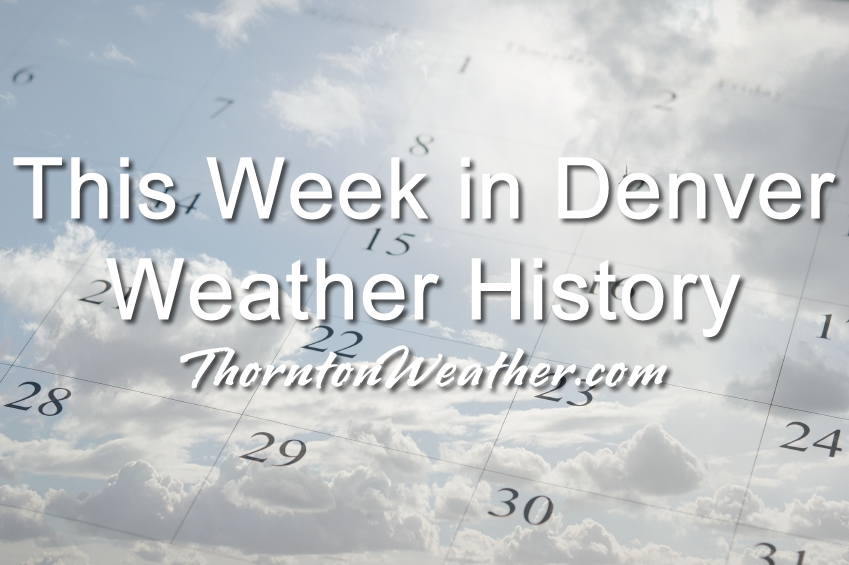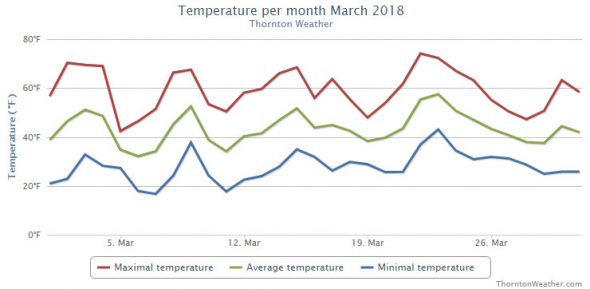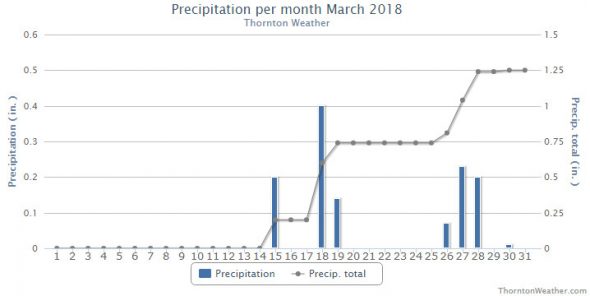Hurricane force winds, heavy snowfall, sub-zero temperatures and even a dust storm highlight some of the events from this week in Denver weather history.
From the National Weather Service:
22-23
In 1985…a snowstorm struck the eastern foothills with 8 to 15 inches of new snow. Three to 7 inches of new snow fell across metro Denver and parts of I-70 were closed at times. Snowfall totaled only 3.3 inches at Stapleton International Airport where northeast wind gusts to 29 mph were recorded.
In 1992…a snow storm dumped heavy snow in the Front Range foothills. Conifer received 12 inches of new snow with 7.5 inches at Aspen Springs. Snow only dusted the plains and metro Denver…but winds were strong with a gust to 43 mph from the north at Stapleton International Airport where snowfall totaled only 0.3 inch. This was the only measurable snowfall of the month…equaling the record for the least snowiest February first set in 1970. Rare thunder for February accompanied the snow during the early morning hours of the 23rd.
In 1999…strong Chinook winds developed on a very localized scale overnight in and near the foothills of northern Jefferson and southern Boulder counties. Peak wind reports included: 82 mph at the Rocky Flats Environmental Test Facility…80 mph at the National Center for Atmospheric Research mesa lab in Boulder…77 mph near Nederland…and 75 mph atop the Gamow Tower on the University of Colorado campus in Boulder.
In 2012…a strong upper level jet stream produced high winds along the Front Range. In Boulder…the strong winds snapped power poles and toppled trees. As a result…about 7 thousand Xcel Energy customers were without power for several hours. The high winds overturned a tractor-trailer on foothills highway overpass…north of Valmont road. The driver suffered minor injuries. A parked car was totaled when it was crushed by a fallen tree near the University of Boulder. The strong winds were also responsible for two Boulder County wildfires which consumed a total of 65 acres. Colorado department of transportation officials closed U.S. 36 at McCaslin Boulevard in both directions after the wind caused damage to the pedestrian overpass. Metal siding from the overpass fell into highway; fortunately there were no injuries. In total…electrical outages affected 46 thousand customers along the Front Range. Damage to roofs…siding… Garage doors and fences was also reported. Peak wind gusts included: 93 mph near Lyons; 88 mph at NCAR Mesa Lab; 85 mph…2 miles southwest of Rocky Flats; 82 mph…5 miles northwest of Boulder; 81 mph…2 miles north of Longmont…4 miles east-northeast of Nederland…the National Wind Technology Center and near Wondervu; 80 mph at the junction of highways 72 and 93; 79 mph at the Boulder Municipal Airport; 78 mph…6 miles northwest of Boulder; 77 mph at Rocky Mountain Municipal Airport; 76 mph atop Berthoud Pass; 75 mph near Aspen Springs; 70 mph at Longmont Municipal Airport; 64 mph at Erie Municipal Airport. At Denver International Airport…peak wind gusts of 53 mph on the 22nd and 55 mph on the 23rd were observed.
22-29
In 1960…heavy snowfall of 6.1 inches at Stapleton Airport on the 22nd and 23rd marked the beginning of a protracted cold spell which lasted until the end of the month. The cloudy… Cold weather was accompanied by occasional light snow or flurries and fog. New record low temperatures for the dates were set on the 24th thru the 29th with the lowest temperature of 11 degrees below zero on the 28th. The seven consecutive days of low temperatures of zero or below had been exceeded in duration only 4 times previously. New low maximum temperatures for the dates were set on the 23rd… 24th…and the 26th thru the 29th with the lowest maximum temperature of 8 degrees recorded on the 26th.
23
In 1904…west winds sustained to 42 mph with gusts as high as 60 mph warmed the temperature to a high of 63 degrees.
In 1907…a thunderstorm…relatively rare in February…was observed over the city. The chance of occurrence is around once every ten years.
In 1977…while 60 to 100 mph winds produced a huge dust storm over much of eastern Colorado…only an experimental windmill at the Rocky Flats nuclear plant was destroyed in the Denver area. Winds at Rocky Flats were clocked to 90 mph. Northwest winds gusted to 46 mph at Stapleton International Airport.
In 1986…wind gusts to 79 mph were clocked at Echo Lake in the foothills west of Denver.
In 1992…a rare February thunderstorm occurred. This was only the 5th time since 1891 that thunder has been heard in February.
In 1994…periodic high winds occurred over the higher elevations of the Front Range eastern foothills. The strongest wind gusts reached 87 mph atop Squaw Mountain near Idaho Springs. Southwest winds gusted to only 25 mph at Stapleton International Airport.
In 1996…high winds gusting as high as 76 mph were reported along the Front Range foothills and adjacent urban corridor. Wind gusts to 70 mph were reported atop Table Mesa near Boulder and to 63 mph in Broomfield. West winds gusted to 38 mph at Denver International Airport.
In 2012…bands of moderate to heavy snow…associated with a strong upper level jet…formed over the southern Front Range foothills…Palmer Divide and southern Denver suburbs. Storm totals included: 10 inches…2 miles west-northwest of Highlands Ranch and Kiowa; 9.5 inches near Castle Rock and Littleton; 8 inches at Aspen Springs and Marston Reservoir; 7.5 inches at Evergreen and Louviers; 7 inches…5 miles south-southwest of Arapahoe Park; with 4 to 6 inches elsewhere. Officially…Denver International Airport observed 1.9 inches of snowfall.
23-24
In 1935…northwest winds sustained to 37 mph with gusts as high as 47 mph produced considerable blowing dust behind a cold front on the 23rd. The dust was dampened by 7.0 inches of snowfall over downtown Denver from the late evening of the 23rd through the evening of the 24th.
In 1997…heavy snow fell in the foothills. Snowfall totals included 8 inches at sunshine canyon northwest of Boulder… And 6 inches at Morrison. Snowfall totaled only 2.4 inches at the site of the former Stapleton International Airport. East winds gusted to only 22 mph at Denver International Airport on the 23rd.
23-25
In 1912…a severe winter storm dumped 14.2 inches of snowfall over downtown Denver. Snow fell continuously from 9:40 am on the 23rd until 9:15 pm on the 25th with most of the snow… 9.2 inches…on the 24th. Temperatures were mostly in the 20’s. Northeast winds were sustained to 20 mph on the 24th.
24
In 1908…a dust storm occurred in the city from mid-morning through mid-day. North winds were sustained from 30 to 35 mph.
In 1927…northwest winds were sustained to 42 mph with an extreme velocity to 46 mph.
In 1924…fog deposited a light coating of glaze…which was very thin and only accumulated on the windward side of cold objects. Streets and sidewalks became slippery.
In 1956…a strong cold front produced north wind gusts to 54 mph…but left only 2.0 inches of snowfall at Stapleton Airport.
In 1959…heavy snowfall totaled 7.5 inches at Stapleton Airport…where north-northeast winds gusted to only 18 mph.
In 1968…west-northwest winds gusted to 49 mph at Stapleton International Airport. The strong Chinook winds warmed the maximum temperature to 61 degrees…the highest temperature of the month that year.
In 1986…wind gusts to 65 mph were reported at Table Mesa in Boulder. West winds gusted to only 28 mph at Stapleton International Airport where the high temperature of 70 degrees equaled the record for the date.
In 1991…the only measurable snowfall for the month totaled only 0.8 inch at Stapleton International Airport where north winds gusted to 28 mph. The light snow fell for most of the day.
In 1994…high winds raked the eastern foothills. Wind speeds of 70 to 80 mph were common. Wind gusts to 110 mph were recorded at the National Center for Atmospheric Research in south Boulder…while in north Boulder winds gusted to 95 mph. The strong winds blew the roof off a building at Red Rocks Community College in Lakewood…causing the evacuation of about 1500 people. A semi-trailer and a delivery truck were overturned. In Lakewood…a home under construction was destroyed by the winds. There were numerous reports of vehicles damaged by flying debris…and many automobile windshields were shattered. West wind gusts to 47 mph were recorded at Stapleton International Airport.
In 2013…a storm system near the four corners region produced heavy upslope snowfall in and near the Front Range with blizzard conditions further east as it made its way across southern Colorado. In the Front Range mountains and foothills storm totals included: 27 inches near Pinecliffe; 24 inches…13 miles northwest of Golden; 20 inches near Genesee; 17 inches near Conifer; 15 inches near Jamestown; 14 inches…just southwest of Eldorado Springs; 12.5 inches near Aspen Springs; 12 inches near Evergreen and Ward; 10 inches at Eldora Ski Area; with 8 inches near Gross Reservoir…Idaho Springs and Nederland. Across the urban corridor storm totals included: 12 inches in Aurora; 11.5 inches near Highlands Ranch; 11 inches in Lakewood; 10.5 inches just north of Longmont and Westminster; 10 inches in Lone Tree and Thornton; 8.5 inches in Aurora…6 miles southwest of Denver and near Loveland; 8 inches at Boulder… Broomfield…and Ralston Reservoir; 7.5 inches near Frederick…with 7 inches at Commerce City. The storm prompted the cancellation of 200 flights in and out of Denver International Airport. Officially…the storm system produced 9.1 inches of snow at DIA which established a new daily snowfall record in Denver for the date. Along and south of the I-70 corridor and east of Denver…the combination of heavy snow and strong wind produced blizzard conditions. Storm totals included: 14 inches…10 miles south-southeast of Buckley AFB…10.5 inches…8 miles southeast of Watkins; with 6 inches near Byers. Northerly winds of 25 to 30 mph were common with gusts to 40 mph. At DIA…a peak wind gust of 32 mph was observed.
Continue reading February 23 to March 1: This Week in Denver Weather History


